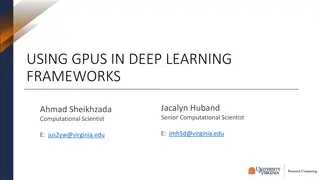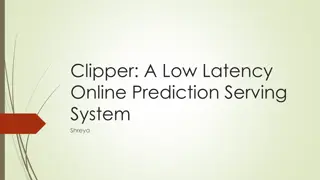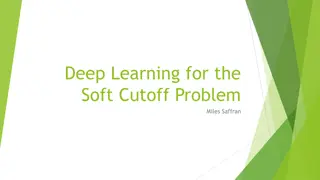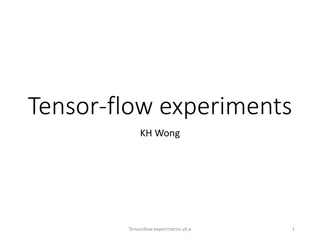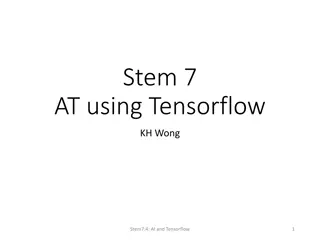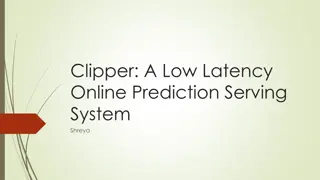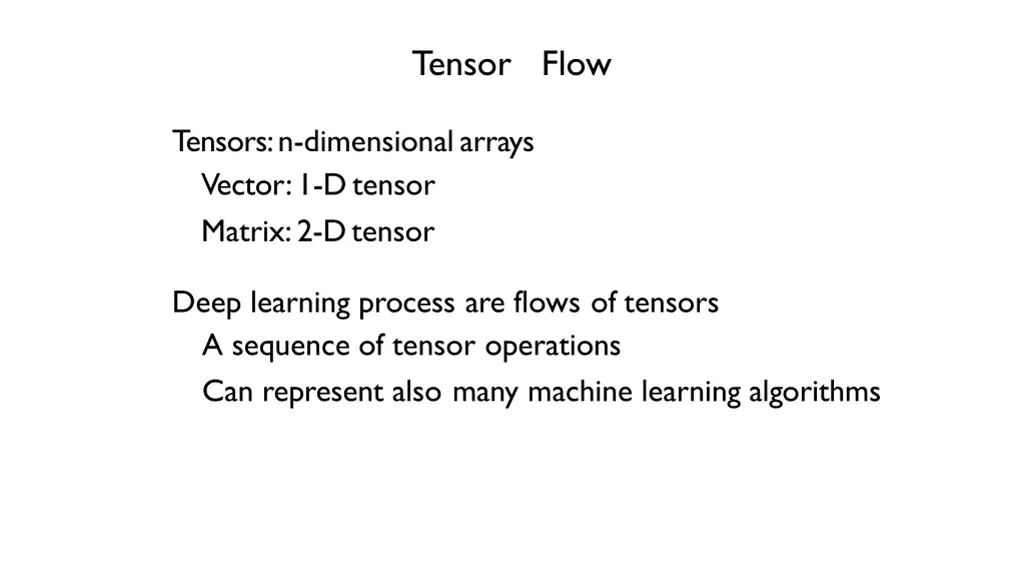
Understanding TensorFlow: Deep Learning with Tensors
Explore the world of TensorFlow, where tensors are used to represent n-dimensional arrays. Learn how tensor flow sequences drive machine learning algorithms, including ReLU networks, and delve into matrix operations for efficient processing.
Download Presentation

Please find below an Image/Link to download the presentation.
The content on the website is provided AS IS for your information and personal use only. It may not be sold, licensed, or shared on other websites without obtaining consent from the author. If you encounter any issues during the download, it is possible that the publisher has removed the file from their server.
You are allowed to download the files provided on this website for personal or commercial use, subject to the condition that they are used lawfully. All files are the property of their respective owners.
The content on the website is provided AS IS for your information and personal use only. It may not be sold, licensed, or shared on other websites without obtaining consent from the author.
E N D
Presentation Transcript
Tensor Flow Tensors: n-dimensionalarrays Vector: 1-Dtensor Matrix: 2-Dtensor Deep learning process are flows of tensors A sequence of tensor operations Can represent also many machine learning algorithms
A simple ReLU network (ReLU: Rectified Linear Unit) a1=a0wa,a+b0wb,a+c0wc,a b1=a0wa,b+b0wb,b+c0wc,b c1=a0wa,c+b0wb,c+c0wc,c Apply relu( ) on a1,b1,c1 Slower approach Per-neuron operation More efficient approach Matrix operation a1 b1 c1 w a0 b0 c0
As matrix operations wa,a wa,b wa,c . = a0 b0 c0 a1 b1 c1 wb,a wb,b wb,c a1 b1 c1 wc,a wc,b wc,c w =relu( =relu(b1 =relu( ) ) ) a1 a1 a0 b0 c0 b1 c1 c1
WithTensorFlow import tensorflow as tf x w wa,a wa,b wa,c a1 b1 c1 . a0 b0 c0 a1 b1 c1 = wb,a wb,b wb,c w wc,a wc,b wc,c y = tf.matmul(x,w) a1 =relu( =relu( =relu( c1 a0 b0 c0 ) ) ) a1 b1 b1 c1 out = tf.nn.relu(y)
DefineTensors xa,a xa,b xa,c xb,a xb,b xb,c xc,a xc,b xc,c Variable(<initial-value>, name=<optional-name>) w import tensorflow as tf w = tf.Variable(tf.random_normal([3, 3]),name='w') y = tf.matmul(x,w) relu_out = tf.nn.relu(y) Variable stores the state of current execution Others are operations
TensorFlow Code so far defines a data flow graph Each variable corresponds to a node in the graph, not the result Can be confusing at the beginning ReLU Variable MatMul x import tensorflow as tf w = tf.Variable(tf.random_normal([3,3]),name='w') y = tf.matmul(x,w) relu_out = tf.nn.relu(y)
TensorFlow ReLU Code so far defines a data flow graph Needs to specify how we want to execute the graph Session Manage resource for graph execution Variable MatMul x import tensorflow as tf sess = tf.Session() w = tf.Variable(tf.random_normal([3, 3]),name='w') y = tf.matmul(x,w) relu_out = tf.nn.relu(y) result = sess.run(relu_out)
Fetch Fetch Graph ReLU Retrieve content from a node We have assembled the pipes Fetch the data MatMul Variable x import tensorflow as tf sess = tf.Session() w = tf.Variable(tf.random_normal([3, 3]),name='w') y = tf.matmul(x,w) relu_out = tf.nn.relu(y) print sess.run(relu_out)
Fetch InitializeVariable Graph ReLU Variable is an empty node Fill in the content of a Variable node MatMul Variable x import tensorflow as tf sess = tf.Session() w = tf.Variable(tf.random_normal([3, 3]),name='w') y = tf.matmul(x,w) relu_out = tf.nn.relu(y) sess.run(tf.initialize_all_variables()) print sess.run(relu_out)
Fetch Placeholder Graph ReLU How about x? placeholder(<data type>, shape=<optional-shape>, name=<optional-name>) Its content will be fed MatMul Variable x import tensorflow as tf sess = tf.Session() x = tf.placeholder("float", [1,3]) w = tf.Variable(tf.random_normal([3, 3]),name='w') y = tf.matmul(x,w) relu_out = tf.nn.relu(y) sess.run(tf.initialize_all_variables()) print sess.run(relu_out)
Fetch Feed Graph ReLU Pump data into the pipe MatMul Variable x import numpy as np import tensorflow as tf sess = tf.Session() x = tf.placeholder("float", [1,3]) w = tf.Variable(tf.random_normal([3, 3]),name='w') y = tf.matmul(x,w) relu_out = tf.nn.relu(y) sess.run(tf.initialize_all_variables()) print sess.run(relu_out,feed_dict={x:np.array([[1.0,2.0,3.0]])}) Feed
Session management Needs to release resource after use sess.close() Common usage with tf.Session() as sess: Interactive sess = InteractiveSession()
Prediction Softmax Make predictions for n targets that sum to 1 import numpy as np import tensorflow as tf with tf.Session() as sess: x = tf.placeholder("float", [1,3]) w = tf.Variable(tf.random_normal([3, 3]),name='w') relu_out = tf.nn.relu(tf.matmul(x,w)) softmax = tf.nn.softmax(relu_out) sess.run(tf.initialize_all_variables()) print sess.run(softmax,feed_dict={x:np.array([[1.0,2.0,3.0]])})
Prediction Difference import numpy as np import tensorflow as tf with tf.Session() as sess: x = tf.placeholder("float", [1,3]) w = tf.Variable(tf.random_normal([3, 3]),name='w') relu_out = tf.nn.relu(tf.matmul(x,w)) softmax = tf.nn.softmax(relu_out) sess.run(tf.initialize_all_variables()) answer = np.array([[0.0, 1.0,0.0]]) print answer - sess.run(softmax,feed_dict={x:np.array([[1.0,2.0,3.0]])})
Learn parameters:Loss Define loss function Loss function for softmax softmax_cross_entropy_with_logits( logits, labels,name=<optional-name>) labels = tf.placeholder("float", [1,3]) cross_entropy = tf.nn.softmax_cross_entropy_with_logits( relu_out, labels,name='xentropy')
Learn parameters:Optimization Gradient descent class GradientDescentOptimizer GradientDescentOptimizer(learning rate) learning rate = 0.1 labels = tf.placeholder("float", [1,3]) cross_entropy = tf.nn.softmax_cross_entropy_with_logits( relu_out, labels,name='xentropy') optimizer = tf.train.GradientDescentOptimizer(0.1) train_op = optimizer.minimize(cross_entropy) sess.run(train_op, feed_dict= {x:np.array([[1.0,2.0,3.0]]),labels:answer})
Iterative update Gradient descent usually needs more than one step Run multiple times labels = tf.placeholder("float", [1,3]) cross_entropy = tf.nn.softmax_cross_entropy_with_logits( relu_out, labels,name= xentropy') optimizer = tf.train.GradientDescentOptimizer(0.1) train_op = optimizer.minimize(cross_entropy) for step in range(10): sess.run(train_op, feed_dict= {x:np.array([[1.0,2.0,3.0]]),labels:answer})
Add parameters for Softmax Do not want to use only non-negative input Softmax layer softmax_w = tf.Variable(tf.random_normal([3,3])) logit = tf.matmul(relu_out,softmax_w) softmax = tf.nn.softmax(logit) cross_entropy = tf.nn.softmax_cross_entropy_with_logits( logit, labels,name= xentropy')
Add biases Biases initialized to zero w = tf.Variable(tf.random_normal([3,3])) b = tf.Variable(tf.zeros([1,3])) relu_out = tf.nn.relu(tf.matmul(x, w) + b) softmax_w = tf.Variable(tf.random_normal([3,3])) softmax_b = tf.Variable(tf.zeros([1,3])) logit = tf.matmul(relu_out, softmax_w) +softmax_b softmax = tf.nn.softmax(logit)
Make it deep Add layers x = tf.placeholder("float", [1,3]) relu_out = x num_layers = 2 for layer in range(num_layers): w = tf.Variable(tf.random_normal([3, 3])) b = tf.Variable(tf.zeros([1,3])) relu_out = tf.nn.relu(tf.matmul(relu_out, w) +b)
Visualize the graph TensorBoard writer = tf.train.SummaryWriter( '/tmp/tf_logs',sess.graph_def) tensorboard --logdir=/tmp/tf_logs
Improve naming, improvevisualization name_scope(name) Help specify hierarchical names Will help visualizer to better understand hierarchical relation for layer in range(num_layers): with tf.name_scope('relu'): w = tf.Variable(tf.random_normal([3, 3])) b = tf.Variable(tf.zeros([1,3])) relu_out = tf.nn.relu(tf.matmul(relu_out, w) +b) Move to outside the loop?
Add name_scope for softmax Before After
Add regularization to the loss eg.L2 regularize on the Softmax layer parameters Add it to the loss Automatic gradient calculation l2reg = tf.reduce_sum(tf.square(softmax_w)) loss = cross_entropy + l2reg train_op = optimizer.minimize(loss) print sess.run(l2reg)
Use activation as bias Everything is a tensor
Residual learning He et al.2015 ILSVRC 2015 classification task winner
Visualize states Add summaries scalar_summar y histogram_summary merged_summaries = tf.merge_all_summaries() results = sess.run([train_op,merged_summaries], feed_dict= ) writer.add_summary(results[1],step)
Save and load models tf.train.Saver( ) Default will associate with all variables all_variables() save(sess, save_path, ) restore(sess, save_path, ) Replace initialization That s why we need to run initialization separately
Convolution conv2d(input, filter, strides, padding, use_cudnn_on_gpu=None,name=None)
LSTM BasicLSTMCell # Parameters of gates are concatenated into one multiply for efficiency. c,h = array_ops.split(1,2,state) concat = linear([inputs, h],4 * self._num_units,True) # i = input_gate,j = new_input,f = forget_gate,o = output_gate i,j,f,o = array_ops.split(1,4,concat) new_c = c * sigmoid(f + self._forget_bias) + sigmoid(i) * tanh(j) new_h = tanh(new_c) * sigmoid(o)
Word2Vec withTensorFlow # Look up embeddings for inputs. embeddings = tf.Variable( tf.random_uniform([vocabulary_size,embedding_size],-1.0,1.0)) embed = tf.nn.embedding_lookup(embeddings,train_inputs) # Construct the variables for the NCE loss nce_weights = tf.Variable( tf.truncated_normal([vocabulary_size,embedding_size], stddev=1.0 / math.sqrt(embedding_size))) nce_biases = tf.Variable(tf.zeros([vocabulary_size])) # Compute the average NCE loss for the batch. # tf.nce_loss automatically draws a new sample of the negative labels each # time we evaluate the loss. loss = tf.reduce_mean( tf.nn.nce_loss(nce_weights,nce_biases,embed,train_labels, num_sampled,vocabulary_size))
Reuse Pre-trained models Image recognition Inception-v3 military uniform (866):0.647296 suit (794):0.0477196 academic gown (896):0.0232411 bow tie (817):0.0157356 bolo tie (940):0.0145024
Try it on yourAndroid TensorflowAndroid Camera Demo Uses a Google Inception model to classify camera frames in real-time,displaying the top results in an overlay on the camera image. github.com/tensorflow/tensorflow/tree/master/tensorflow/ examples/android
Reinforcement Learning usingTensor Flow github.com/nivwusquorum/tensorflow-deepq
Using Deep Q Networks to LearnVideo Game Strategies github.com/asrivat1/DeepLearningVideoGames

